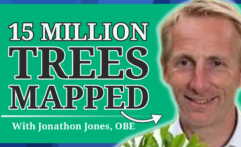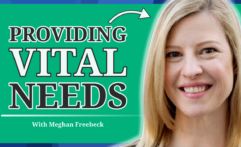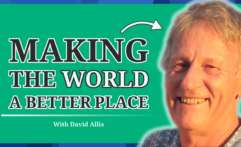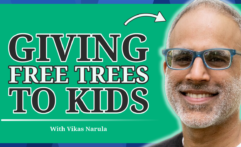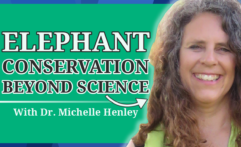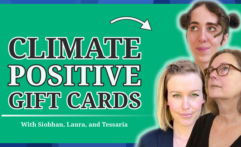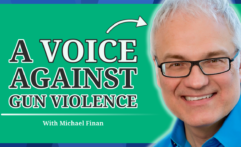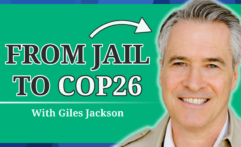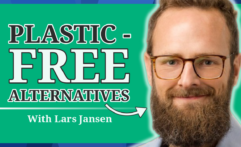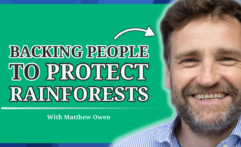How to Enable Gardeners to Share Their Harvest With Local Pantries: Gary Oppenheimer from AmpleHarvest.org (#19)
Impactful Ninja is reader-supported. When you buy through links on our site, we may earn an affiliate commission.
Learn more
Learn more
.
Hey fellow impactful ninja ? You may have noticed that Impactful Ninja is all about providing helpful information to make a positive impact on the world and society. And that we love to link back to where we found all the information for each of our posts. Most of these links are informational-based for you to check out their primary sources with one click. But some of these links are so-called "affiliate links" to products that we recommend. First and foremost, because we believe that they add value to you. For example, when we wrote a post about the environmental impact of long showers, we came across an EPA recommendation to use WaterSense showerheads. So we linked to where you can find them. Or, for many of our posts, we also link to our favorite books on that topic so that you can get a much more holistic overview than one single blog post could provide. And when there is an affiliate program for these products, we sign up for it. For example, as Amazon Associates, we earn from qualifying purchases. First, and most importantly, we still only recommend products that we believe add value for you. When you buy something through one of our affiliate links, we may earn a small commission - but at no additional costs to you. And when you buy something through a link that is not an affiliate link, we won’t receive any commission but we’ll still be happy to have helped you. When we find products that we believe add value to you and the seller has an affiliate program, we sign up for it. When you buy something through one of our affiliate links, we may earn a small commission (at no extra costs to you). And at this point in time, all money is reinvested in sharing the most helpful content with you. This includes all operating costs for running this site and the content creation itself. You may have noticed by the way Impactful Ninja is operated that money is not the driving factor behind it. It is a passion project of mine and I love to share helpful information with you to make a positive impact on the world and society. However, it's a project in that I invest a lot of time and also quite some money. Eventually, my dream is to one day turn this passion project into my full-time job and provide even more helpful information. But that's still a long time to go. Stay impactful,Affiliate Disclosure
Why do we add these product links?
What do these affiliate links mean for you?
What do these affiliate links mean for us?
What does this mean for me personally?
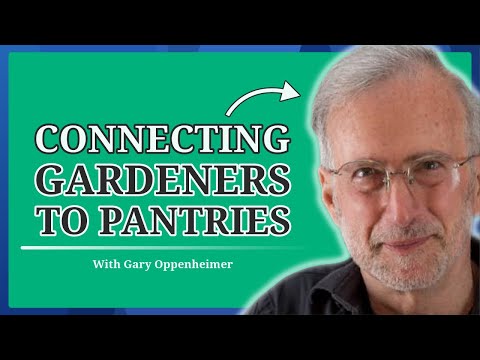
Did you know that about 50% of US produce goes to waste while tens of millions of people suffer from food insecurity? This and so much more is what we’ll talk about in our conversation together with Gary Oppenheimer from AmpleHarvest.org!
“AmpleHarvest.org does not feed a hungry family one meal. Instead it diminishes hunger and malnutrition permanently and does it by using healthy food already available in the community.”
Gary Oppenheimer, AmpleHarvest.org
Three Key Points You’ll Learn From This Episode
How connecting gardeners with local food pantries is key…
How their unique approach helps reduce food waste and improve food security…
How they were able to scale their impact while staying lean…
About Gary Oppenheimer

Gary is a self-described aging geek who worked with computers and communications going back to the 1970s. As director of a community garden in 2009, he learned about the wasted food in many garden plots and created a local hands-on version of what would become AmpleHarvest.org to get the surplus harvests to local food pantries. Realizing this as a nationwide problem, he created a nationwide solution called AmpleHarvest.org using the Internet educate, encourage and enable millions of growers nationwide to share their surplus harvests with local food pantries in all 50 states. He is also a long-distance cyclist, hiker, farmer, and dancer.
About AmpleHarvest.org
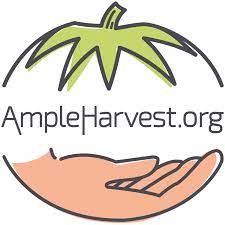
AmpleHarvest.org is a nationwide nonprofit that is eliminating the waste of 11 billion pounds of fresh garden produce per year. They work predominantly with America’s 62 million backyard gardeners and its 32,500 neighborhood food pantries, which is significantly different from other programs in that food pantries are local and food banks are regional. Through AmpleHarvest.org, gardeners in all 50 states connect with their local food pantry and donate their surplus harvests. They make produce donation a large scale opportunity, not just one for farmers and community gardens.
Links and Additional Information Discussed
You can donate directly to AmpleHarvest.org. Every single dollar donated helps connect one gardener to a local food pantry for many years to come.
You can become a business partner of AmpleHarest.org and put your brand logo on the food pantry listing of every food pantry in the state that you are located in.
You can find AmpleHarvest.org on X, Facebook, Instagram, Pinterest, LinkedIn, YouTube, and TikTok
The Full Transcript
Dennis: Hello, and welcome to the Impactful Ninja Show. I’m your host, Dennis Kamprad. And today, we’re joined by Gary Oppenheimer from AmpleHarvest.org. Gary, welcome.
Gary: Thank you. I’m thrilled to be here with you, and thank you very much for the opportunity.
Dennis: It’s my pleasure having you. I’m super excited to, to find out more about Ample Harvest, which is a good starting point. Give us a brief overview. What is AmpleHarvest.org, and what are you doing there?
Gary: AmpleHarvest.org is a, today, 15 year old nationwide nonprofit or NGO that’s been at work across the United States to solve 2 problems simultaneously. 1 is the desperate need for fresh food at America’s food pantries, And the other is the food waste problem that occurred in America’s 62,000,000 gardens, when gardeners grew too many tomatoes or zucchini or what have you. The gardeners thought they couldn’t donate the food, and they didn’t even know where they could, and the food pantries thought they couldn’t receive it. AmpleHarvest.org bridges the 2 groups together, or what I like to tell people, we’re an information based nonprofit just like Uber and Lyft are information companies solving a transportation problem. They are not actually transportation companies. We’re not a gardening program. We’re using information to bridge these 2 segments in society together for a sustained solution to hunger and food waste.
Dennis: So it sounds like there’s there’s a lot of demand, obviously, for for food for those who are hungry. There’s a lot of surplus supply from food from the gardeners. And you’re providing the technology in an uber uberized way, to connect those 2, to basically help on both sides.
Gary: The answer is yes. And the interesting thing to think about is in the United States, 40% of our food and 50% of our produce goes to waste. It’s thrown away. It’s never consumed. So while we have tens of millions of people who are hungry or food insecure, it’s not because we don’t have the food. We have plenty of food. We’re just not using the food we have, and in the United States, everybody’s always presumed, and with good justification, that food comes from the farm. It’s a farm-to-table thing, and they’ve overlooked the reality that there’s 11 million pounds of surplus harvests in America’s gardens, and the heart of Ample Harvest dot org is enabling that 11 million pounds of freshly harvested food to go to a hungry family in the same neighborhood, and for that to go on year after year after year at zero cost to the donor and at zero cost to the food pantry.
Dennis: Beautiful, Can’t wait to to jump super deep into and get, get to know much more about the program and all your work there. Let’s rewind slightly. What did you do before starting amplharvest.org? What’s your background?
Gary: I tell people I’m an aging geek. Mhmm. And my background is that I came out of college with a degree in psychology and immediately realized I would not be a good psychologist. My wife thinks the world is better for that. But I fell in love with what were then called mini computers. This was before we had personal computers. Mini computers were computers that were about the size of your refrigerator. We’re talking in the mid 19 seventies, and I became a programmer.
Gary: I worked for the banks on Wall Street, and then later on, I got I was an early person in what we then called microcomputers. These are the hobby computers in the late seventies and early eighties. So I became a programmer. I enjoyed programming. Mid 1980s, I get involved in electronic mail. I started working this is before there was an Internet, by the way. I started working with a company called MCIMail, and I was working under a gentleman named Vince Cerf. If the name rings a bell, he’s the father or grandfather of the Internet.
Gary: So I was selling email and working with her for many, many years, and my experience has always been connecting to disconnected things. So for example, I invented the electronic newsletter. Mhmm. I did not invent spam. That was somebody else. By 1986, I started producing the first electronic newsletter when I realized MCIMail was an email company that wasn’t communicating with its own customers. Mhmm. These little pieces all came together at a later date, but as we wound down in the nineties, email was changing, the Internet became popular, the MCIMail was winding down, and I thought maybe it’s gonna be time to retire or whatever.
Gary: I started doing a number of little things, but eventually, in 2,006, 2007, my own garden was producing a lot of food, and my wife reached the point, she said, don’t bring any more of that in the house. I was bringing way too much food. I am a first generation American. My family escaped the Nazis, but as a child in the fifties, I grew up with finish what’s on your plate. Kids are starving in Europe. I was inculcated with the idea that you don’t waste food, and built into my DNA is don’t waste food, don’t waste time, don’t waste energy, don’t waste money, etcetera, but really use what you got, use it judiciously, and I didn’t want the food in my garden going to waste, So I visited a battered women’s shelter in my town. I said, I have food. Would you like it? And the lady who took it was very, very graciously appreciative, and she said something that caught my ear.
Gary: She said, oh good, now we can have fresh food. Mhmm. And I thought that’s an odd thing to say. The following year, I came back to the same place with more food, same lady and same response. That year, I was asked to take over a community garden in my own town. I did, and in meeting with the people there who were already in the garden, they explained to me that they were frustrated because towards the end of the gardening season, there was a lot of food left over. People were bored. People were overwhelmed.
Gary: They didn’t like it going to waste. And I said and I’d never used this phrase before. I said, if we’re going to have an ample harvest, the least we can do is get it to hungry families.
Gary: They loved the idea. That was the moment AmpleHarvest.org was born. I did some research. I discovered that Google really didn’t have any food pantry listings. We put them a program together for my town. I’m in rural Northern New Jersey. We have several food pantries in the town, and then I realized that I couldn’t find food pantries on Google. That means that everybody else, would, and I’m one of the early people in computers and the Internet, and I couldn’t find it, so that must affect every other gardener too.
Gary: So in March of ‘nine, 15 years ago this month, actually, I woke up with an idea. I just had this epiphany, and I sat down in PowerPoint, and I mapped out a vision of how to solve the problem I and my community garden had, but to do it nationwide, what would be involved. And I had a 4 hour session with PowerPoint. And when I was done, I realized I had mapped out exactly what AmpleHarvest.org is today. My evangelical friends think I was doing it. The Lord was speaking through me. That makes them happy. I’m fine.
Gary: This is just me as a problem solver realizing that this was really an information problem. Mhmm. We gardeners in the United States, when you donate food to a food bank, they always always say jars, cans, boxes, no fresh food. So we were always told, don’t donate fresh food, which means you couldn’t donate your garden produce. And the food pantries, which needed the food, were afraid of getting fresh food because they thought they needed costly refrigeration. We had misinformation, I can’t donate the food, missing information to where to donate the food, and I realized this was a solvable problem. Create a program that educates the gardeners that they can donate the food, and then enable them to donate the food by creating a search engine of food pantries that would like to get the food. And to solve the refrigerator problem, I realized that you had to incorporate what’s called just in time inventory logic.
Gary: Have the food arrive just before the hungry families are gonna come in to get the food. So then I harvest the food, maybe in the morning, I take it to the food pantry in the morning, it’s laid out at a table, A few hours later, the hungry people, who live in my own community, by the way, they may be my neighbors, come and get the food, and it goes home with them. The food never need to be refrigerated, and they’re getting food fresher than you and I can buy in a supermarket. That’s the heart of AmpleHarvest.org.
Dennis: Wow. So it’s like so many different strings happen at the same time, but yet kind of continuously as well. So you had, let’s kind of start from the point when you had, kind of, the problem yourself. As as a gardener, you had too much produce. And with your cultural background and your upbringing, also, you knew it’s not gonna be wasted. At the same time, you had and back in 2009 roughly, you had the issue of not being able to find too much information about, like, can you bring the fresh harvest? You thought not, but the food pantries were happy. What could be the best food pantries? How could they get the, the hungry people just in time so that they don’t have to start? And at the same time, there’s a second part that comes in quite nicely. Your background from already working with in programming from the seventies up until the date of being able to have a look at these problems of a programmer’s mind.
Gary: Yeah. The whole thing, I viewed it very differently than other people did. People think and and this is why I started the discussion earlier about the food waste in America. People think the solution to hunger is more food. Mhmm. But when you have enough food, the real issue is using the food you already have. And by the way, this is, food fresher, as I said, than you and I can buy in a supermarket. So the two primary efforts that I had to put together, all the first of all, it would involve building a website, and I’m not a web designer.
Gary: So I found 2 volunteers who actually helped to build the website. 1 is a woman in Missouri who I’ve never met. She herself had previously gone to a food pantry to get food, And we built the program. So in March of 0 9, I have the idea. It took 9 weeks for all the pieces to come together. May 18th 2009, Ample Harvest delivers ready to go live. There’s no nonprofit.
Gary: There’s no NGO at this point, so it’s just an aging geek with an idea doing guerrilla marketing, and I started going out partnering with Feeding America, literally making phone calls, sending emails out, and food pantry started signing up. I had realized that they really, really wanted this. It took a 150 days for 1,000 food pantries across America to sign up. Oh, wow. That was one person doing it. And this, by the way, was during the time in we had an economic meltdown in the United States. The economy hit a bottom. And we also, by the way, had a fungus.
Gary: I was wiping out tomato and potato crops in the eastern half of the country. But anyway, started rolling it out. I actually went to Google. Now remember I just mentioned the gentleman Vint Cerf before, the father or grandfather of the Internet? Vint works at Google. I said, can Google help me? Mhmm. I got this idea. He loved it, and the result has been that since 2009, Google has been supporting Apple Harvest, Zillow. We get almost half a $1,000,000 a year of free advertising from Google year over year, so Google’s a big part of the hero story about ending hunger and food waste in America.
Gary: The program rolled out, gardeners started hearing about it. I’m a master gardener. So there was this balancing act, we get more food pantries, get more gardeners, get more food pantries, get more gardeners, and it just took off like crazy. In April of 2010, almost a year later, I was named CNN Hero. And in December of 2011, I’m at the White House with the president and Michelle Obama for the holiday party. I ultimately had 7 visits with the Obama White House. It was a big part of Michelle Obama’s efforts for her program called Let’s Move, which involves healthy eating, and we’re working again now with the Biden White House on reducing the hunger and food waste across the country. Today, and by the way, we incorporated as a nonprofit or NGO in April 2010, I believe it was.
Gary: So we’re now becoming an official nonprofit. I was able to get employees eventually. This small organization working today in over 5,600 communities with 8,000 food pantries and now on Native American reservations Mhmm. Is managed by 4 people.
Dennis: Oh, wow.
Gary: Because you don’t need people in all the communities, you can orchestrate entirely virtually. And by the way, I built the program. I I work out of a home office. Mhmm. And the people I hired work out of their home offices too. I had one woman working for me for 3 years before I learned that she was taller than me because I had never met her. So when the pandemic hit and everybody was trying to figure out, oh my god, how do I work from home? We’d already been doing it for years. We just kept on moving along.
Gary: We were tooled for that. We had remote was built in, contactless donations were built in. All the things that were needed for a pandemic, we were already doing. Today, AmpleHarvest.org is working with more than 8,000 food pantries. It’s about a quarter of all the food pantries in America, and, we’re we are right now, this minute, doing a survey of gardeners in America to learn more, but what we’ve learned right now is 3 quarters of all the food pantries in our network are receiving food, which is absolutely amazing. Beautiful. Now one of the things we did was we realized that 70% of food pantries are in a house of worship. That made the faith community a logical partner, so we built an adjunct program called Faith Fights Food Waste to enable Christian, Jewish, Muslim, Hindu, Buddhist, and Unitarian clergy to give sermons about food waste.
Gary: Part of it is encouraging gardeners to donate the food, so even if we don’t reach a gardener through whether it’s Google or social media, 88,000,000 people in America go to a house of worship once a week, and their pastor, their imam, their rabbi will be telling them about donating food. Now, another piece of what we’ve done is we had realized that a large swath of America, the center part of America, we weren’t quite having the impact that we should have been having. We were making a lot of impact in the Eastern half of the United States and the West Coast and when doing some research, we discovered that much of where we weren’t being very effective were Native American reservations, where the tribal communities in the United States are. So during pandemic, we did research and partnered with Native Americans and built a special version of Ample Harvested Oil that met the needs and challenges of those communities, and that now is rolling out.
Dennis: There’s a lot of things to unpack as well. So you already had a super strong start when you started. It sounded like the first, one of the first challenges was getting basically getting the visibility, getting the website, and you already had the help from 2 volunteers who could greatly help you out of this. And instead of building having to build, like, just a website, you basically had to build a database. Being able for food pantries to sign up, you got, like, a 1,000 food pantries super quick in the beginning, but then also for people to connect over them.
Gary: Yeah. Everything was basically creating a platform for information without having the other people populated.
Dennis: Yes. And then fast forward, it seems like the vast majority of the food pantries have signed up already. You mentioned that you’re generously getting a lot of Google ad credits. When it comes to, kind of, the progression, especially when it’s it’s kind of 3 key players here, that you kind of need to tailor your efforts. To. One, it’s the food pantries to receive. It’s the gardeners to deliver to deliver just in time because then there’s also the people who are consuming the food, basically.
Gary: Well, we don’t touch them. Mhmm. And that’s the interesting thing. One of the real challenges for us, interestingly, in terms of getting financial support from foundations is we don’t give hungry people food. We simply get food to the food pantry. They get the food to the hungry people. The people who are food insecure have never heard of AmpleHarvest.org. The problem in the entire food system was that there was a disconnect between the gardener and the food pantry.
Gary: The food pantry is the proxy for the hungry families, because our 3 parties actually are the gardener. You’re correct. The food pantry. And lastly, finding the businesses and the foundations and the individuals to financially fund ample harvest of the earth so that we can do our work. That’s our bigger challenge, because we’re solving a problem most people never heard about, and we’re certainly solving in a way nobody ever actually thought about. So right now, our primary corporate partners are Bonnie Plants, which is the largest supplier of seedlings in America. Mhmm.
Gary: If you go to the store and you wanna buy a tomato plant or pepper plant or zucchini, there’s a good chance it came from this company called Bonnie Plants. And the other one is one of the largest chain of stores for home improvement called Home Depot. Mhmm. And so they’re partnering with AmpleHarvest.org to help also many millions more gardeners learn that the solutions to hunger is in the backyard. So you’re right about the messaging. To the gardeners, we wanna say that the solution to your hunger is in your backyard. Yep. You can donate the food.
Gary: To the food parents, you wanna say that there are millions of gardeners in America and thousands near you that wanna donate the food. Join AmpleHarvest.org. It’s totally free, and to the funders, we wanna say, we have a solution that is not a transactional one. It’s not give me money, we give food to people, then give me more money, we give food to people, which is how hunger programs go. This is provide the support we need so that we can fix a break in the system, and then food flows on a sustained basis. I’ll give you one number. A Harvard trained economist looked at the analysis of the whole system, and this is pre pandemic when we had 42,000,000 gardeners versus today 62,000,000. So this information’s out of date.
Gary: But if in the in the test, if all the gardeners in America knew about donating food, and if all the food pantries in America were connected to be able to receive it, America’s health care costs would drop $58,000,000,000 per year by virtue of reductions in diabetes, obesity, etcetera. The food that is available for donation would feed 23,000,000 people. It’s £11,000,000,000 of food. That number’s gonna greatly jump now with the new data that we’re collecting in in the post pandemic world, so it’s a massive opportunity for the country, and it’s easily done. It’s friction free. By the way, it’s also the one thing that both the Democrats and the Republicans both agree on. So in this very divided country, there is actually something that both sides of the country can collaborate on.
Dennis: Yep. I can imagine also from when it comes to the messaging that it’s quite might be quite challenging at times also getting the message out. When it comes to the food pantries, you mentioned like 3 quarters of food pantries already signed up. Beautiful. No. One quarter. Oh, sorry. One quarter. Misspoke here. One quarter already signed up. So there is some some kind of limit and you’re already reaching big steps there.
Gary: Yeah. Let let me say this. The food pantry we have partnered with Feeding America, and they’re helping to let the food pantries learn about it. And it’s just an ongoing process. A big piece of the problem we had, by the way, is during the pandemic when a lot of the elderly senior citizens who volunteer at food pantries said, I’m not gonna volunteer because I don’t wanna get sick. Many food pantries close to over a 1000 food pantries disappear from our network. We are rebuilding that. I think that we will easily eventually get to probably 50%, 75% of America’s food pantries.
Gary: An important thing is this. The focus that we have is can a gardener donate food to a food pantry? So if I live in a community where there are 2 food pantries down the street, I don’t need to have 2 food pantries in ample harvest. Don’t don’t get me wrong. It would be great if they both did, but one of them is fine. We don’t need to have every single one up there. We just wanna make it so that a gardener doesn’t have to drive more than 10 miles or 20 minutes to get to a food pantry. If the gardener has to go 2 hours across Texas, they’re not gonna waste the time or the gas, so we don’t have to have a 100% penetration on the food pantry side for the system to fully build out. And on the gardening side, we have a another thing at work, and this is something I couldn’t say during the pandemic, but the program is viral.
Gary: If I’m a gardener, and I learned that I could donate food to St. Mary’s Food Pantry, and then Dennis, who’s my next door neighbor, tells me, I’ve got too many tomatoes. I am likely to tell Dennis about St. Mary’s Food Pantry. In effect, he didn’t hear about AmpleHarvest.org through Google or anything else. He learned about donating directly from me. I’ve become the vector for the information. And then as time goes on, when Dennis, his next door neighbor, has the same problem, so it does spread that way.
Dennis: That’s a perfect thing about when I say Tides product market fit, and people really enjoy it. And it’s easy easy messaging as soon as they came in contact and heard about Ampleharvest dotorg. And then they can also, with word-of-mouth, well, basically tell their neighbors and tell everyone else.
Gary: I was gonna say, the goal is to make this as routine and as easy as donating old clothing to a thrift shop, which is something everybody does.
Dennis: And everyone knows about moving that.
Gary: Yeah. And by the way, we don’t have to convince gardeners or beg them to donate. They hate wasting the food. They know how valuable the food is. We simply have to enable them to do it. Mhmm. So this is not pushing them to do it.
Gary: It’s opening the doors and allowing and then enabling them to do it. Yep.
Dennis: So if there was one KPI to check for you, it would be how much of the food waste you’ve reused from all the gardeners as opposed to like how many food prints you sent up. The most important thing is that all there’s no more food waste from gardeners in an ideal world, and it goes all to the closest food printries, whichever those would be.
Gary: Yeah. But I would make the argument that it is not the KPI isn’t the food. It’s the gardener. Mhmm. And I’m gonna give you a thought experiment for a minute. If, for argument’s sake, every gardener in America knew about donating food, every single one, and they were all therefore able to donate, but if a drought or blight wiped out every garden in America that year and no food was donated, the question is, are we success or a failure? I would make the argument that the opportunity to donate the food is there. The fact that there is no surplus food is not a failure. It’s simply a circumstance.
Gary: It’s like having a storm drain on a road on a sunny day. It’s not a failure. It’s just waiting for the rain, and when there’s rain, it takes the surplus water away. Yeah. So it requires different thinking. This is one of the challenges with working with funders is their focus is on food rather than a systemic change and systemic improvement.
Dennis: Is that now that you already mentioned the challenge, would you say that’s also one of the biggest challenges for you to to enable all the gardeners to to donate their food to food pantries and get the word out there?
Gary: The word get it continues to spread. I mean, the as I said, the viral thing, Google, Bonnie Plants, Home Depot, and others. I mean, if we turned off the lights today and said ample harvest automobiles shut off, it’ll still spread virally. It just would happen much, much slower. My goal is to have that massive end game of all the garden and roller pantries happen in an ever shortening amount of time. The sooner that happens, the sooner hungry families get the food. By the way, there was also something else we I keep talking about hungry families or food insecure families. The key thing about ample harvest.org is the food that they’re getting is nutritious.
Gary: I can give you potato chips, and you won’t be hungry, but you also won’t be nourished. As a matter of fact, one of the problems in America is that we’re exceedingly well fed, but malnourished, which is why obesity is such a problem. Ample harvest alert opens a floodgate up of fresh food, particularly important to children, but also to families as a whole.
Dennis: Nice. It’s good that you can’t crawl these chips in the garden. Yeah. One thing that you mentioned also beforehand is about just in time foods delivery so that there’s no refrigerators needed. How did you solve that issue for the food pantries?
Gary: Again, it’s an information thing historically. Let’s pretend the food pantry is only open on Sundays, and they give food they give the food out Sunday. I’m a gardener. I show up on Monday. Well, now the pantry has to refrigerate the food for a week until Sunday. That costs money. It costs electricity, and that’s what the food pantries were afraid of. They need refrigeration for the milk and the cheese, but for me to come in with watermelon or bulky things, they don’t have the space.
Gary: And what I realized from the piece that Ample Harvest dot org introduced is that the food pantry can tell the gardener the day of the week and the time of day to come. Now the gardener knows now when to harvest because they would like me to come on Sunday morning. I’ll harvest Saturday night or Sunday morning, and that, by default, creates this just in time flow, because now the food is gonna be delivered just before the hungry families come, and that’s how it goes out. There’s an ethical piece in this also that’s very, very important. The food is going staying in my neighborhood, staying in my community. It’s not going across the country. It’s entirely possible that my friend, my next door neighbor lost his job, fell on hard times, and she’s going to a food pantry to get bread and milk and cheese. If I was there donating food while she’s there getting food, I might be embarrassed, and she might feel humiliated.
Gary: That’s unnecessary. By separating us by a little bit of time, by me coming in 2 hours before she comes in, I know it’s going to somebody in my neighborhood, but I don’t know who. She knows it came from someone in her neighborhood. She doesn’t know who. There’s no reason for her to be in any way embarrassed or humiliated because she’s getting help from a neighbor or friend, and this anonymity, I think, is a very important thing to uphold the dignity of the individual. But this, by the way, also opens up another rare opportunity that ample harvest that all brings to the table. My neighbor who’s going to a food pantry may have been a gardener. Mhmm.
Gary: And the fact that she lost her job and needs a food pantry, she still has tomatoes, she still has corn in her backyard, and she may well still have too much of it. Mhmm. So she has a chance now to to take the surplus tomatoes and to bring them to the food pantry herself and donate it while she’s getting the bread and milk and cheese. That adds an element of dignity because I’m not just asking for help. I’m offering help. It’s a different element that comes into the equation.
Dennis: Nice. Now let’s take a look into the future of AmpleHarvest.org. Like, if you if you could think, like, a few years ahead, what would be an ideal scenario for you? How would you envision the future for for you?
Gary: Ultimately, and ultimately, it’s not a few years. It may be 5 years. It may be 25 years ended. But, ultimately, Ample Harvest of the Road should be able to put itself out of business. I really believe that a good nonprofit should find a problem, solve it, and go home. Food banks, which are always feeding people, will never solve a problem because there’s always there’s always gonna be I need people food and feed people. I mean, feeding people goes back to biblical times or earlier, but with ample harvest that are when a preponderance of gardeners know they can donate food. Mhmm.
Gary: And a preponderance of food pantries are visible to them. We have largely solved the problem of gardeners not knowing and food pantries. We have largely fixed that. Now you may make the argument, well, ample harvest will be needed as a search engine to find a pantry. You may be right about that, but in large part, we will have gone a great distance to actually solve the problem, and if we were to turn off the lights, America would not become malnourished and hungry again. The food wouldn’t be wasted. The food would be able to come in. The goal is to work towards that end.
Gary: Will we make it? I don’t know, but we’re well on the way. This is, and I can see it’s not hyperbole the only program of its kind in America and possibly the world. And we share this knowledge, by the way, with other countries. I have shared it with maybe a dozen countries, and I’ve said, this is what we did in the United States. Here’s how you can make your own version, and then that country can make their own version of it.
Gary: But ultimately the goal is to make sure that if you’re a gardener, that you know that you can donate the food where and when, and that if you are a food pantry, that you know that there are people in your community who are eager to donate the food, in your own community, and you can take care of your family, and hopefully you will have less diet related disease, and by the way, also an improved environment. I should have mentioned this earlier. Food waste is, I think, the number 3 contributor to climate change. To the extent that food is not wasted, the climate’s benefits, and also the food that was wasted was also wasted water that was used for irrigation, wasted electricity. There are a number of of of secondary, tertiary benefits that come out of simply not wasting the food.
Dennis: Beautiful. I love it how how you’re solving one big issue, but if there’s so many little parts and every single player that you help solving this issue. Every single player benefits from that.
Gary: Yeah. This is a root cause solution. I like solving root cause things because you really actually solve it. Instead of reacting to problems, you ultimately are preventing them from happening, and that’s a passion of mine. Nice.
Dennis: Now for everyone listening, what would be the best way for us to to support you? To support AmpleHarvest.org, to support all the food pantries. What would be our best way forward here?
Gary: Number 1 is if you wanna donate to AmpleHarvest.org, the money goes towards helping us more rapidly expand the program to more communities. You can do that directly online. If you work for a corporation or a business, we’d love to partner with you. We’ve done partnerships with the numerous businesses. And by the way, one of the benefits for our business is that partner with Ample Harvest at Home is they get to put their logo, their brand, the food pantry listing of every food pantry in the state that they’re located in. These partnerships are great because the people get to see that you may be a hardware company or you may be a car company, but you care about the health and well-being of the people in the community. So reach out to us, info at AmpleHarvest.org. We’d love to discuss partnering with you, but, again, the donations to AmpleHarvest.org are there to help make sure that the people get the food that they need and the food in the community isn’t wasted, and one other thing about the donation is that when you make a donation, a dollar, $10, $100, it’s not a one time donation from the standpoint that the impact is only we buy food, feed people.
Gary: It has a sustained and lasting impact, and we actually have a tool on our site, so you can see that if you donate whatever amount of money, in 20 years, this is how much is donated, how much food is being received because of your the donation that you made. If you wanna get hands on, you can join us in the effort. We’re always looking to expand our board of directors, board of trustees, And if you have certain skills, particularly in AI or other areas, we’d love to talk with you.
Dennis: Beautiful. We’ll put all the links into the show notes as well so that people can directly find them. And I think one one thing that to remember from from your website as well, just for, like, a thought experiment for our listeners, if you donate $1, that would roughly equate to onboarding 1 gardener. And this 1 gardener gardener, if they stay over their lifetime, that will be a lot of food waste that is reduced and it will be a lot of food that is provided for those in need of just $1.
Gary: Absolutely. It is a what you should think about it is as a sustained solution to hunger and food waste, and the important thing is that when you wanna do something, you’d actually like to fix problems, and that’s the heart of AmpleHarvest.org is actually permanently ending a problem that plagues America, and frankly plagues other countries too, but you can actually make a long term change to this and have, again, healthier families, healthier children, and healthy basically, healthier people and healthier planet.
Dennis: Now that’s also a good transition speaking about, like, long term health and healthier planet and the families as well. If you reflect on the work that you’ve done with AmpleHarvest.org, how would you say has that impacted your personal life?
Gary: That’s a great question. I have gotten the opportunity to meet personally some amazing people, people you have never heard of, just what we call ordinary people, but who are actually extraordinary in what they’re doing. People who say, I’ve donated a £1,000 of food this year, or people I mean, you get to meet people from all walks of life. One of the things I really enjoy doing, by the way, is when I go out and give talks, and I love doing keynote talks and panel talks, I donate a colloquium to a local college or university. I wanna sit down with students, learn about what they wanna do to improve the world, save the whale, gender equality, climate change, whatever’s important to them, and use my story with ample harvest to help guide them to how they can affect the change they want to affect without having to be a billionaire or a rock star or a famous person, but, and this is something I really enjoy doing with students. I go to sleep tired every night, but it’s a great tired. I get up energized every morning, and there is a expression in Hebrew, tikkun olam. It roughly translates to repairing the world, And one of the ideas is that when you, you should leave the place a little bit better than you found it, and that’s what I think I’m bringing with AmpleHarvest.org.
Dennis: Awesome. And now already to our final question. If you had one impactful tip to share with our audience, how we could become more impactful, What would your number one tip be for us?
Gary: You’re going to have a lot of people who are going to say, you can’t do it. It’s impossible to do. If it could have been done, it would have been done. And my answer is to do the impossible, you must first believe it isn’t. Ignore what other people are doing. Ignore what other people are saying. Go do what you think is right. Go in the direction you think is the best way to go.
Gary: Even if you’re not a 100% successful, if you move through the needle, you’re a success.
Dennis: Awesome. I love that one. Resonates so so nicely with my journey as well. Well, thanks. Thanks for joining us, and thanks for all the great work we’re doing with AmpleHarvest.org, Gary.
Gary: Thank you very much. It’s very nice. And, again, anybody wants to talk, reach out. Info AmpleHarvest.org. Thank you again very much, Dennis.
Dennis: My pleasure. And to everyone else, thanks so much for joining us as well. And stay impactful.
